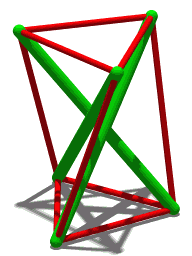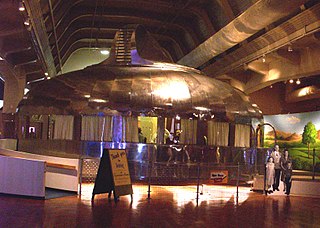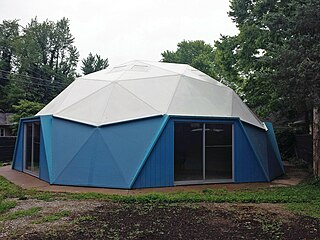
Richard Buckminster Fuller was an American architect, systems theorist, writer, designer, inventor, philosopher, and futurist. He styled his name as R. Buckminster Fuller in his writings, publishing more than 30 books and coining or popularizing such terms as "Spaceship Earth", "Dymaxion", "ephemeralization", "synergetics", and "tensegrity".

A geodesic dome is a hemispherical thin-shell structure (lattice-shell) based on a geodesic polyhedron. The triangular elements of the dome are structurally rigid and distribute the structural stress throughout the structure, making geodesic domes able to withstand very heavy loads for their size.

Tensegrity, tensional integrity or floating compression is a structural principle based on a system of isolated components under compression inside a network of continuous tension, and arranged in such a way that the compressed members do not touch each other while the prestressed tensioned members delineate the system spatially.

The Dymaxion House was developed by inventor and architect Buckminster Fuller to address several perceived shortcomings with existing homebuilding techniques. Fuller designed several versions of the house at different times—all of them factory manufactured kits, assembled on site, intended to be suitable for any site or environment and to use resources efficiently. A key design consideration was ease of shipment and assembly.

The Dymaxion car was designed by American inventor Buckminster Fuller during the Great Depression and featured prominently at Chicago's 1933/1934 World's Fair. Fuller built three experimental prototypes with naval architect Starling Burgess – using donated money as well as a family inheritance – to explore not an automobile per se, but the 'ground-taxiing phase' of a vehicle that might one day be designed to fly, land and drive – an "Omni-Medium Transport". Fuller associated the word Dymaxion with much of his work, a portmanteau of the words dynamic, maximum, and tension, to summarize his goal to do more with less.
World Game, sometimes called the World Peace Game, is an educational simulation developed by Buckminster Fuller in 1961 to help create solutions to overpopulation and the uneven distribution of global resources. This alternative to war games uses Fuller's Dymaxion map and requires a group of players to cooperatively solve a set of metaphorical scenarios, thus challenging the dominant nation-state perspective with a more holistic "total world" view. The idea was to "make the world work for 100% of humanity in the shortest possible time through spontaneous cooperation without ecological damage or disadvantage to anyone," thus increasing the quality of life for all people.

James Tennant Baldwin, often known as Jay Baldwin or J. Baldwin, was an American industrial designer and writer. Baldwin was a student of Buckminster Fuller; Baldwin's work was inspired by Fuller's principles and, in the case of some of Baldwin's published writings, he popularized and interpreted Fuller's ideas and achievements. In his own right, Baldwin was a figure in American designers' efforts to incorporate solar, wind, and other renewable energy sources. In his career, being a fabricator was as important as being a designer. Baldwin was noted as the inventor of the "Pillow Dome", a design that combines Buckminster Fuller's geodesic dome with panels of inflated ETFE plastic panels.
R. Buckminster Fuller coined the term design science revolution to describe his proposed scientific and socio-economic revolution accomplished by shifting from "weaponry to livingry" through the application of what he called comprehensive anticipatory design science. His World Design Science Decade, proposed to the International Union of Architects in 1961, was an attempt to catalyze the revolution.
A concept of design science was introduced in 1957 by R. Buckminster Fuller who defined it as a systematic form of designing. He expanded on this concept in his World Design Science Decade proposal to the International Union of Architects in 1961. The term was later used by S. A. Gregory in the 1965 'The Design Method' Conference where he drew the distinction between scientific method and design method. Gregory was clear in his view that design was not a science and that design science referred to the scientific study of design. Herbert Simon in his 1968 Karl Taylor Compton lectures used and popularized these terms in his argument for the scientific study of the artificial. Over the intervening period the two uses of the term have co-mingled to the point where design science may have both meanings: a science of design and design as a science.

The Biosphere, also known as the Montreal Biosphere, is a museum dedicated to the environment in Montreal, Quebec, Canada. It is housed in the former United States pavilion constructed for Expo 67 located within the grounds of Parc Jean-Drapeau on Saint Helen's Island. The museum's geodesic dome was designed by Buckminster Fuller.

Operating Manual For Spaceship Earth is a short book by R. Buckminster Fuller, first published in 1969, following an address with a similar title given to the 50th annual convention of the American Planners Association in the Shoreham Hotel, Washington D.C., on 16 October 1967.

The Dymaxion Chronofile is Buckminster Fuller's attempt to document his life as completely as possible. He created a very large scrapbook in which he documented his life from 1917 to 1983. Fuller describes his Chronofile as "[contribution] to the scientific documentation of the emergent realization of the era of accelerating-acceleration of progressive ephemeralization". The scrapbook contains copies of all correspondence, bills, notes, sketches, and clippings from newspapers. In 1960, the documents were presented by Fuller to Southern Illinois University's Morris Library where it was housed in their rare book archives. In 1999, the documents were moved to Stanford University. They are currently archived at Stanford University and are occasionally exhibited. Southern Illinois University still archive a collection of Fuller's 3D physical models. They were last displayed in the Hall of Presidents in 2023. The total collection is estimated to be 270 feet worth of paper. This is said to be the most documented human life in history.
Synergetics is the empirical study of systems in transformation, with an emphasis on whole system behaviors unpredicted by the behavior of any components in isolation. R. Buckminster Fuller (1895–1983) named and pioneered the field. His two-volume work Synergetics: Explorations in the Geometry of Thinking, in collaboration with E. J. Applewhite, distills a lifetime of research into book form.

The Pioneer Center for the Performing Arts is a theater located in Reno, Nevada. It was designed by the Oklahoma City architectural firm of Bozalis, Dickinson and Roloff as a concrete structure with a distinctive gold geodesic dome roof. The facility was completed in 1967 with 987 seats on the main level and 513 seats in a balcony, totaling to 1,500. The co-founder of Temcor, the project's contractor, was Don Richter, a student of Buckminster Fuller, developer of the geodesic dome concept. Temcor had built several gold-anodized aluminum domes before the Pioneer, and was responsible for more than 5000 dome projects.

Robert Edward Williams is an American designer, mathematician, and architect. He is noted for books on the geometry of natural structure, the discovery of a new space-filling polyhedron, the development of theoretical principles of Catenatic Geometry, and the invention of the Ars-Vivant Wild-life Protector System for repopulating the Western Mojave Desert in California, USA with desert tortoises.
The Stockade Building System was designed by Richard Buckminster Fuller and his father-in-law, James Monroe Hewlett, and was patented in 1927. Both of them had previously formed a company, in 1922, which made bricks out of compressed wood shavings with vertical holes cast in them.

The R. Buckminster Fuller and Anne Hewlett Dome Home, located at 407 S. Forest Ave. in Carbondale, Illinois, is a geodesic dome house which was the residence of Buckminster Fuller from 1960 to 1971. The house, inhabited by Fuller while he taught at Southern Illinois University, was the only geodesic dome Fuller lived in, as well as the only property he ever owned. Fuller, a prolific architect and engineer, popularized the geodesic dome as a building design, and his house was one of the first geodesic dome residences to be constructed. The home was built and designed by Al Miller of the Pease Woodworking Company. While living in the home, Fuller was awarded nine patents, published eleven books, and designed the Montreal Biosphère, one of his most famous works.

Shoji Sadao was a Japanese American architect, best known for his work and collaborations with R. Buckminster Fuller and Isamu Noguchi. During World War II he was stationed in Germany and was a cartographer for the U.S. Army.
The Fly's Eye Dome was a structure designed in 1965 by R. Buckminster Fuller. Inspired by the eye of a fly, Fuller designed the dome as his idea of the affordable, portable home of the future, with windows and openings in the dome to hold solar panels and systems for water collection, thus allowing the dome to be self sufficient. Before his death in 1983, he hand-built three prototypes of the design:
Buckminster Fuller was an American architect, systems theorist, author, designer, inventor, and futurist.












